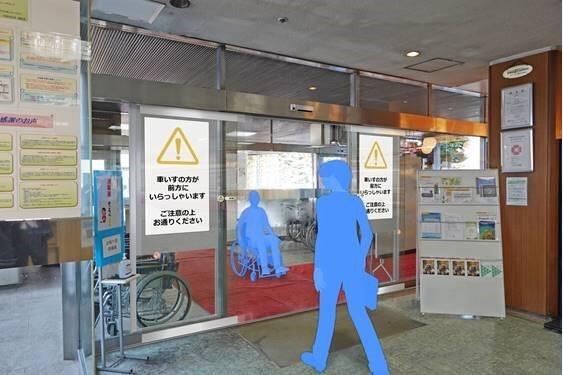St. Marianna Medical University Hospital (Kawasaki, Kanagawa Prefecture), NEC Solution Innovators, Ltd. (Koto, Tokyo), Fulltech Co., Ltd. (Sapporo, Hokkaido), and Kyoritsu Icom, Inc. (Fujieda, Shizuoka Prefecture) conducted a demonstration experiment of an automatic door with consideration for improved safety at St. Marianna Medical University Hospital utilizing AI (artificial intelligence) image analysis technology and digital signage. The implementation period was from April 19 to June 30.
At St. Marianna Medical University Hospital, one of the basic policies is to "provide high quality and communicative medical care with an advanced medical safety management system that puts patient safety first." The hospital is working toward achieving safe medical care as a regional core hospital and a special function hospital. The main entrance of the hospital experiences a considerable amount of traffic owing to visitors arriving from the bus stop in front of the hospital. At the entrance, the body surface temperature of the visitors is measured as a countermeasure against the novel coronavirus disease. Thus, congestion problems may occur at the entrance, which may compromise the safety of visitors. Therefore, the hospital is working with NEC Solution Innovators, Ltd., Fulltech Co., Ltd., which develops automatic doors for the safety and security of passers-by, and Kyoritsu Icom, Inc., which produces signage content, to conduct a demonstration experiment to strengthen safety measures for hospital visitors.
In the demonstration experiment , an automatic door with a camera and digital signage will be installed at the entrance of the hospital, and the state of the visitor (whether or not they require wheelchair assistance) will be detected using the camera image to control the opening/closing speed and opening time of the automatic door. When a wheelchair visitor passes by, the digital signage notifies the visitors on the opposite side of the door to draw their attention. In addition, information such as notifications to visitors and bus timetables will be publicly distributed using the digital signage for the convenience of visitors. Furthermore, by analyzing the camera images, in addition to the mode of visitors, information on the number of visitors entering and exiting can be collected to understand the congestion situation in the hospital. This information can be utilized for decision-making regarding ventilation work and for the disclosure of congestion status and forecasts.
When conducting the demonstration experiment, the image data, including personally identifiable information, is not saved after the mode of the passerby is recognized. In this demonstration experiment, St. Marianna Medical University Hospital was in charge of providing the experiment site and evaluating the results of the experiment. NEC Solution Innovators, Ltd. was in charge of constructing the system used for the demonstration experiment, recognizing the mode of passersby using image analysis technology, linking the data with the automatic doors, and controlling the content displayed in the signage. Fulltech Co., Ltd. was in charge of designing and constructing the automatic doors used for the demonstration experiment, controlling the opening and closing of the automatic door based on the image analysis results, and Kyoritsu Icom, Inc. was responsible for creating the content to be displayed on the signage. Moreover, to further improve the safety and convenience of visitors, NEC Solution Innovators, Ltd. and Fulltech Co., Ltd. strengthened the functions for commercialization so that the automatic doors could identify not only people using wheelchairs but also people using strollers and crutches.

Image provided by NEC Solution Innovators, Ltd.
This article has been translated by JST with permission from The Science News Ltd.(https://sci-news.co.jp/). Unauthorized reproduction of the article and photographs is prohibited.




